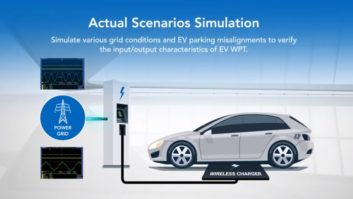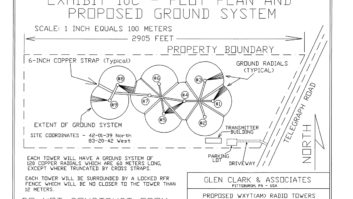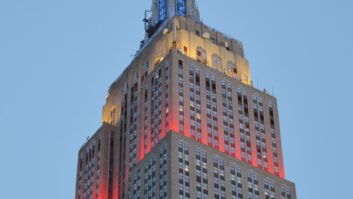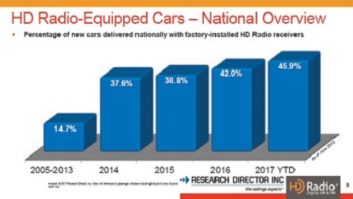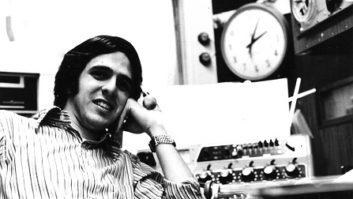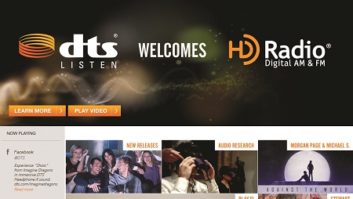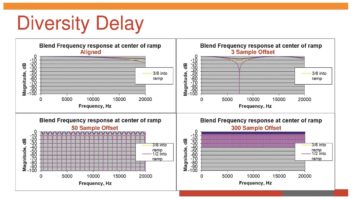Ibiquity Issues User List, Incentive Plan
LAS VEGAS A year ago, many of the conversations Ibiquity Digital executives held with attendees and manufacturers at the spring NAB convention concerned the audio quality of its codec.
“Now, we talk about people buying products,” said Ibiquity Digital President/CEO Robert Struble.
Ibiquity executives feel the digital radio rollout is turning a corner.
The number of stations going digital has passed the 100 mark, and manufacturers are shipping their second and third generations of IBOC transmission products.
The FCC, meanwhile, sought public comments on how it should craft permanent IBOC authorization and operation rules and how to proceed on AM nighttime operation.
Separately, engineers had been asking Ibiquity for a way to monitor their IBOC signals; now Belar Electronics Laboratory Inc. has signed a license with Ibiquity so it can integrate the digital technology into modulation monitors that will allow engineers to monitor the performance of their AM and FM digital broadcasts.
And on the receiver side, Ibiquity’s big push is to get radios to consumers. It has accomplished several tasks to enable this and to help stations promote the technology.
Station incentive
Ibiquity and Crutchfield have signed an agreement to get stations involved in the rollout. A station that is on the air with a digital signal can provide a click-through on its Web site to the Crutchfield site. There, consumers can purchase HD Radios from Kenwood, Panasonic and, later this year, JVC.
For every radio sold in this manner, the station would receive $20 from Ibiquity, paid on a quarterly basis.
“We want to make it easy for consumers to find out about digital radios and to buy them,” Struble said.
One of Ibiquity’s big “ooh, ahhs” for this show was an official list of stations on the air with a digital signal in specific markets. The chart was displayed prominently in the company’s booth.
The station list is available on Ibiquity’s Web site, which has been partly redesigned to make it easier for consumers to learn where to get HD Radios. Struble said, “Customers are asking ‘Where do I go?’ In the past, our Web site has been a business-to-business Web site. Now we want to reach consumers.”
Several companies displayed surround sound capabilities that are meant to dovetail with HD Radio. While these systems are used by satellite radio and attendees of the Consumer Electronics Show have seen the displays, they are new for some broadcast attendees to NAB.
Ibiquity displayed its HD Radio receiver display wall, a traffic data demo and a Perstel radio coming out later this year with recording capability.
Such consumer recording ability, touted as a feature of HD Radio data capabilities, is under attack by the record companies. When it issued its Further Notice about IBOC just before the show, the commission also sought public comment about whether to restrict home recording rights for radio (RW, May 5, page 1).
The recording industry is asking the agency to mandate that stations encrypt their music so that only legal downloads are possible.
Home-recording brouhaha
Several broadcast execs were relieved by the FCC’s approach. They said that by raising the issue in a separate Notice of Inquiry, rather than lumping it in with the rest of the IBOC issues in the Further Notice, the FCC keeps the flag issue not one but two steps away from formal adoption.
NAB’s Senior Vice President and General Counsel Jack Goodman said the trade association had no position yet on the issue.
The Consumer Electronics Association believes the commission will reject the recording industry’s “efforts to restrict the noncommercial home recording of digital radio broadcasts,” said CEA President/CEO Gary Shapiro in a statement.
In its effort to seek comments for formal IBOC authorization and operational rules, the FCC asked the public to submit input on a wide range of topics, including radio’s public service obligations, datacasting, multiplexing and subscriptions services.
“The FCC is asking good questions. They want to see this as a permanent reality,” said Ibiquity Senior Vice President and General Counsel Al Shuldiner. “It’s good for broadcasters. We’re talking (with them) about how to implement, not whether to implement HD Radio.”
Another question the commission raised is whether there should be a minimum audio quality level should stations split their digital signals into two channels.
NPR Vice President of Government Relations Michael Riksen said the network was pleased to have its secondary audio channel concept discussed in the item and “took that as a recognition that Tomorrow Radio will be a part of HD Radio going forward.”
When asked by an attendee how NAB and commercial broadcasters feel about the secondary audio channels, Riksen quipped, “I think we’re about to find out,” referring to the mid-June deadline for comments on the digital radio issue. Commissioner Michael Copps has said the split-channel concept raises ownership concerns.
Noncommercial stations are heavily represented among those that have licensed Ibiquity’s technology, spurred by matching grant money from the Corporation for Public Broadcasting.
“We’ve worked hard, in four years, to ask and justify to Congress why we need transition money,” said Riksen.
What about AM?
The commission also seeks public input on nighttime digital operation for AMs. Ibiquity executives are hopeful that will be allowed this year.
A few AM stations reportedly have taken their digital signals off the air due to interference to analog neighbors on adjacent channels. Ibiquity executives said transmission gear manufacturers are helping to work out implementation issues.
For later this year, expect to see more HD Radios roll into store shelves. JVC’s is due out this month; Onkyo and Yamaha plan to ship home units later this year, Struble said.
When will consumers see HD Radios in cars? Bill Whikehart, senior technical specialist with Visteon, said automakers do want products such as digital radios that help differentiate their offerings. Visteon has an OEM contract for HD Radio receivers and is being asked to provide quotes on the devices for other automakers.
Struble predicts the market will see in-dash HD Radios next year, in 2006 model cars. Car radio sales are expected to build cash flow for Ibiquity. Struble predicts the company will break even “before 2007.”
Caution
Yet with all the good news about HD Radio during the show, Shapiro sounded a cautionary note. He warned that radio continues to lose market share from CDs, MP3 and video technologies in the car.
Broadcasters need to embrace and promote HD Radio, he said. “Radio has a small window of opportunity to do this. Ibiquity has a business model that will work,” he said.
“Digital is coming, but complacency could be your swan song.”
As implementation choices increase, manufacturers say they’re ready to help more stations convert. Attendance at Broadcast Electronics’ HD Radio seminar at the show was strong; roughly 200 engineers attended, twice the number company President John Pedlow said was expected.
Given that HD Radio equipment continues to evolve, BE is offering a new HD Radio equipment deal. The company’s Vice President of RF Systems Tim Bealor said, “We want to make sure the products you buy today don’t paint you into a corner. Tell us what you need today. We will guarantee a price for 3 years.”
According to a flyer passed out at the meeting, “BE guarantees that, should you purchase a transmitter from us in 2004 without HD Radio implementation, we will provide you with a firm quotation, valid for three years, on the BE HD Radio components you plan to purchase at a later date.”
Glynn Walden, senior vice president for engineering at Infinity Broadcasting, was honored with NAB’s Radio Engineering Achievement Award for his hand in designing the Ibiquity HD Radio system. In Walden’s 30-year career in radio, he has devoted 14 to digital radio development.
He thanked “all the GMs who let me work on IBOC” and scores of people, including Derek Kumar and his former Ibiquity colleague Rick Martinson; he singled out Martinson, now with Northrop Grumman, “who led the ‘dream team’ to excellence.”





